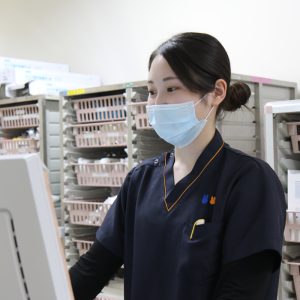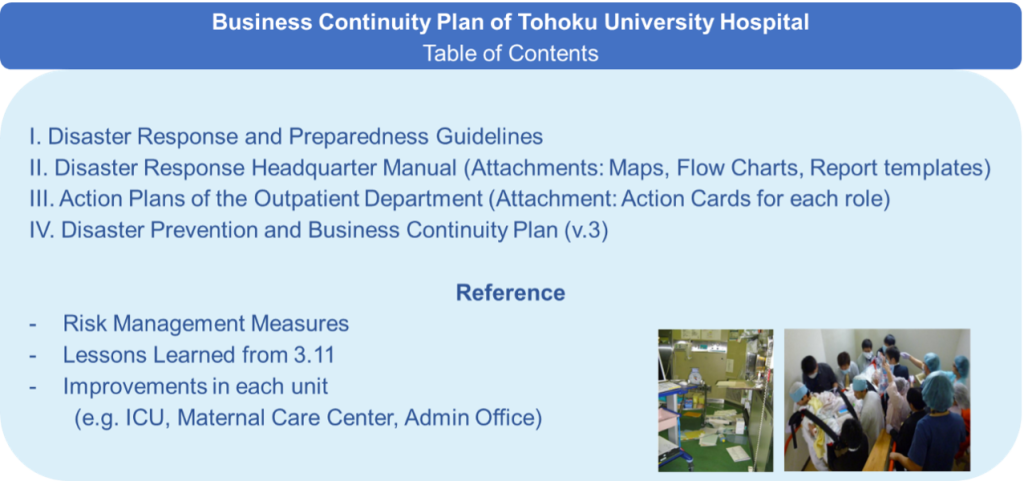
お知らせ
世界銀行イントラに当院主導のCOVID-19対応(徳田 香子 特任教授らが共著)が掲載されました
世界銀行のブログ(関係者のみ閲覧可)に、徳田 香子特任教授(客員)との共著で、東日本大地震の経験に基づいたCovid-19への対応について掲載されました。
共著者:徳田 香子 特任教授(客員)、石井 正 教授(総合地域医療教育支援部 部長)、德田 浩一 特命教授(感染管理室 室長)、中川 敦寛 特任教授(EDAS-TUHデザイン室 室長)、張替 秀郎 教授(副病院長)、冨永 悌二 教授(病院長)
以下、世界銀行のブログ(関係者のみ閲覧可)より転載。
Hospital-Led Preparedness and Multisectoral COVID-19 Response in the 3.11 Great East Japan Earthquake-Affected Tōhoku
Kyoko Tokuda, Tadashi Ishii, Koichi Tokuda, Atsuhiro Nakagawa, Hideo Harigae, and Teiji Tominaga
March 11, 2022
Keywords:Pandemic preparedness, COVID-19, Building Back Better, multisectoral partnerships
Building Back Better from the 3.11 Earthquake and Tsunami, and Preparedness
The youngsters who survived the earthquake and tsunami in Tōhoku, Japan, have now come of age. Eleven years ago today, Marie Nakamura, then a junior high school student, experienced a magnitude 9.0 earthquake. The 2011 Great East Japan Earthquake and Tsunami event motivated her to realize her childhood dream. Eight years later, Marie became a certified nurse and started working at the Department of Emergency and Critical Care Medicine of the Tōhoku University Hospital in Sendai, Miyagi Prefecture. Then, another disaster hit—COVID-19.
Despite the outbreak of the Omicron variant in January 2022, Miyagi Prefecture’s government managed to control its spread and host in-person coming-of-age ceremonies for young adults in the month. What is behind this success? Tōhoku University Hospital has led Building Back Better since the March 11 (3.11) Tsunami; that effort has been reflected in and enabled its pandemic preparedness.
Since 2011, Tōhoku University Hospital has worked on translating lessons learned from the series of natural disasters into strengthening its preparedness, including the establishment of the Business Continuity Plan of the Tōhoku University Hospital.


The hospital is the largest in the tsunami-affected Tōhoku area, with 1,200+ beds, 3,000+ staff, and 50+ departments; it serves as a designated “Advanced Treatment Hospital,” for patients who are referred from other medical institutions. Nevertheless, Dr. Teiji Tominaga, director of Tōhoku University Hospital, did not limit the hospital’s function to serving only as an “advanced” health care provider. He redefined that role to also provide “community-based” health care. Dr. Tominaga discovered the hospital’s advantage in its diverse human resources for health, including medical doctors, researchers, and doctorate students, and thereby believed that the hospital could play a critical role in establishing a resilient health system in the community. Based on this sense of mission, together with the enormity of the natural disaster in 2011, Tōhoku University Hospital could better respond to the unexpected COVID health crisis by organizing fit-for-purpose frameworks by engaging local governments and medical resources in a timely manner.
Japan’s Low Infection and Fatality Rates
Japan has one of the highest risks of COVID-19 due to its rapidly aging population, yet it has relatively low numbers of infection and fatality rates. Certain factors are widely believed to be responsible for this outcome, including its unique geography (e.g., no land-connected borders), pre-installed universal health coverage (UHC) infrastructure (e.g., health insurance coverage), cultural practices (e.g., socially distanced greetings), and widely accepted preventive measures (e.g., wearing masks).

Among Japan’s densely populated prefectures, Miyagi Prefecture with 2.3 million people has been particularly successful in managing COVID. It recorded the lowest level of both infection and fatality rates (as of February 2022).
Below is a comparison of other municipalities that have the same population size but lower density (as of February 2022).

Source: Retrieved from New York Times Online, “Tracking Coronavirus in Brazil: Latest Map and Case Count” (Updated March 2, 2022).
Hospital-Led Preparedness and Whole-of-Society Approach to COVID-19
“Tōhoku University Hospital functioned as the headquarters of a response to the Earthquake and Tsunami disasters in 2011. All the stakeholders in Miyagi Prefecture were fully aware of our hospital’s role in disaster responses. We also understood who can do what. We were on the same page when COVID-19 arrived. This was an enabler of our swift cross-sectoral response to the new threat.” (Dr. Teiji Tominaga)
The above implies that lessons learned from the disaster experience of 2011 led to the largely successful management of COVID-19 in Miyagi Prefecture. The disaster experience–based preparedness enabled Miyagi Prefecture to better control COVID-19 impacts on people, the health system, and society than did other major prefectures in Japan.
Having that disaster experience and preparedness enabled a stronger response in dealing with an unexpected situation: Tōhoku University Hospital jump-started the COVID-19 response in March 2020.

Source: Co-authors
Tōhoku University Hospital has played a central role in promoting and implementing the whole-of-society approach to this unknown disease from the earliest stages of the pandemic. The hospital identified the following five paths and, along with multiple stakeholders, accordingly allocated financial and human resources.


Source: Co-authors
Context-Specific and People-Centered Response to “Leave No One Behind”
Preparedness is crucial in responding to any form of emergency. The solidarity generated among Miyagi Prefecture’s various stakeholders was capitalized on for the COVID-19 response. Motivated by the experiences of addressing an unpredictable and cataclysmic event, in collaboration with the authorities and medical institutions, the 2011 earthquake and tsunami survivors have invested in preparedness and been able to jump-start a multisectoral COVID-19 response.
“Even our heart-breaking experience such as the Tsunami and COVID-19 should leave us lessons learned for future pandemics and disasters—if we seriously face what happened. COVID-19 has physically separated me from patients and colleagues. However, each one of us plays an expected role, and thus I feel we are all connected.” (Marie Nakamura)
Acknowledgments
The coauthors benefitted from the administrative and substantive support of Mr. Toru Kodama, Tōhoku University Hospital. His kind contribution to the interview and data analysis is deeply appreciated.
Coauthors:
Kyoko Tokuda, Specially Appointed Professor (visitor), Advanced Graduate Program for Future Medicine and Health Care
Tadashi Ishii, Professor, Department of Education and Support for Regional Medicine, Tōhoku University Hospital; Department of Comprehensive Medicine, Tōhoku University School of Medicine
Koichi Tokuda, Special Appointed Professor and Director, Division of Infection Control, Tōhoku University Hospital
Atsuhiro Nakagawa, Special Appointed Professor and Assistant to Hospital Director, Tōhoku University Hospital
Hideo Harigae, Professor and Codirector, Tōhoku University Hospital
Teiji Tominaga, Professor and Director, Tōhoku University Hospital

 TEL
TEL アクセス
アクセス
 交通アクセス
交通アクセス










